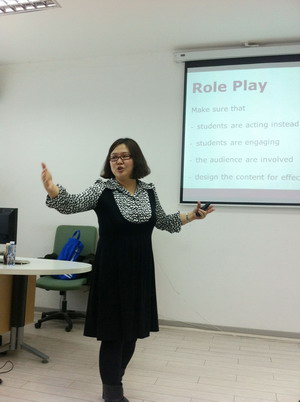Always Learning: How to teach grammar? --A Trainer from Pearson gave a workshop about English teaching
A Trainer from Pearson gave a workshop about English teaching
On the 14th of March 2013, we invited Ms Minghua Piao from the world's leading learning company Pearson to present a workshop about English teaching to the teachers of International Department.
The workshop started with an interesting game called the HAND game, which has very simple rules but is hard to follow. This game illustrates the seemingly paradoxical way English grammar is easy to understand, but very hard to follow in practice.
In the presentation, Ms Piao covered seven pedagogical guidelines and techniques for teaching grammar.
She also concluded concrete example exercises for each of them.
1. "Using Acceptable Logic"
Express general grammatical rules in a way a child can easily understand.
Examples include how to teach students which indefinite article ("a", "an") to use, how to teach the prepositions "over", "in" and "under" through use of illustrative pictures.
2. "One Thing at a Time"
Do not confuse children by adding too much complexity to a rule.
An example given is "He/She has two pens". The teacher shouldn’t teach this sentence at once since it includes two rules ("He/She" being third singular and "pens" being plural) and confuses the students. The better way is to teach "he/she has" and "I have" firstly until the students master these knowledge.
3. "Task-based Learning"
Use grammatical rules as part of the tasks, to allow the students to use them more naturally.
For example, in the shopping game, students are given a set amount of money to buy things. They naturally must use singular or plural nouns depending on how many things they wish to buy.
4. "Teach for Outcome"
An example given here is teaching countable and uncountable nouns. The teacher firstly shows students pictures of countable things and lets them count, then pictures of uncountable things and lets the students compare them with the former ones. Through comparison, students learn the difference between countable and uncountable nouns. Afterwards the outcome is that students learn countable nouns can go after number words and should be put an "s" in the end when the number is more than one.
5. "Chunks work better"
Sentences can be taught divided into chunks.
For example, "There is a lamp on the desk" can be split into 3 parts, "There is", "a lamp", "on the desk" and taught to the students with 3 different gestures. This makes sentences especially long sentences easier to remember.
6. "caffolding"
The teacher should use abstract representations to visualize the rules or concepts.
For example, various pictures should be given to visualize concepts such as "this" and "that", showing relative distances to a reference point.
7. "Peer Learning"
An example is given how students may learn grammar in a group. Students are divided into four groups and given cards to arrange in the correct order; the first group to correctly arrange the cards wins. This "assembly line" game allows students to learn together.
In the end of the workshop, Ms Piao gave some suggestions for giving well organized, well structured and inclusive lessons. These suggestions are applicable not only to English teaching but also to any other lessons.
After attending the workshop, the teachers said they had benefited a lot and would apply these techniques to their class teaching in future.








 京公网安备 11010502030723号
京公网安备 11010502030723号